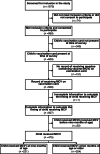Does mothers' and caregivers' access to information on their child's vaccination card impact the timing of their child's measles vaccination in Uganda?
- PMID: 35473625
- PMCID: PMC9044684
- DOI: 10.1186/s12889-022-13113-z
Does mothers' and caregivers' access to information on their child's vaccination card impact the timing of their child's measles vaccination in Uganda?
Abstract
Introduction: On-time measles vaccination is essential for preventing measles infection among children as early in life as possible, especially in areas where measles outbreaks occur frequently. Characterizing the timing of routine measles vaccination (MCV1) among children and identifying risk factors for delayed measles vaccination is important for addressing barriers to recommended childhood vaccination and increasing on-time MCV1 coverage. We aim to assess the timing of children's MCV1 vaccination and to investigate the association between demographic and healthcare factors, mothers'/caregivers' ability to identify information on their child's vaccination card, and achieving on-time (vs. delayed) MCV1 vaccination.
Methods: We conducted a population-based, door-to-door survey in Kampala, Uganda, from June-August of 2019. We surveyed mothers/caregivers of children aged one to five years to determine how familiar they were with their child's vaccination card and to determine their child's MCV1 vaccination status and timing. We assessed the proportion of children vaccinated for MCV1 on-time and delayed, and we evaluated the association between mothers'/caregivers' ability to identify key pieces of information (child's birth date, sex, and MCV1 date) on their child's vaccination card and achieving on-time MCV1 vaccination.
Results: Of the 999 mothers/caregivers enrolled, the median age was 27 years (17-50), and median child age was 29 months (12-72). Information on vaccination status was available for 66.0% (n = 659) of children. Of those who had documentation of MCV1 vaccination (n = 475), less than half (46.5%; n = 221) achieved on-time MCV1 vaccination and 53.5% (n = 254) were delayed. We found that only 47.9% (n = 264) of the 551 mothers/caregivers who were asked to identify key pieces of information on their child's vaccination card were able to identify the information, but ability to identify the key pieces of information on the card was not independently associated with achieving on-time MCV1 vaccination.
Conclusion: Mothers'/caregivers' ability to identify key pieces of information on their child's vaccination card was not associated with achieving on-time MCV1 vaccination. Further research can shed light on interventions that may prompt or remind mothers/caregivers of the time and age when their child is due for measles vaccine to increase the chance of the child receiving it at the recommended time.
Keywords: Child health; Cross-sectional survey; Immunisation; Measles; Public health.
© 2022. The Author(s).
Conflict of interest statement
The authors declare that they have not competing interests.
Figures






References
Publication types
MeSH terms
Grants and funding
LinkOut - more resources
Full Text Sources
Medical

